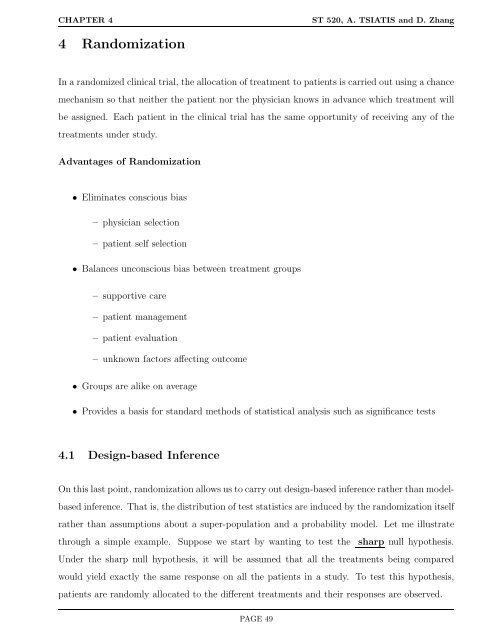ST 520 Statistical Principles of Clinical Trials - NCSU Statistics ...
ST 520 Statistical Principles of Clinical Trials - NCSU Statistics ...
ST 520 Statistical Principles of Clinical Trials - NCSU Statistics ...
You also want an ePaper? Increase the reach of your titles
YUMPU automatically turns print PDFs into web optimized ePapers that Google loves.
CHAPTER 4 <strong>ST</strong> <strong>520</strong>, A. TSIATIS and D. Zhang<br />
4 Randomization<br />
In a randomized clinical trial, the allocation <strong>of</strong> treatment to patients is carried out using a chance<br />
mechanism so that neither the patient nor the physician knows in advance which treatment will<br />
be assigned. Each patient in the clinical trial has the same opportunity <strong>of</strong> receiving any <strong>of</strong> the<br />
treatments under study.<br />
Advantages <strong>of</strong> Randomization<br />
• Eliminates conscious bias<br />
– physician selection<br />
– patient self selection<br />
• Balances unconscious bias between treatment groups<br />
– supportive care<br />
– patient management<br />
– patient evaluation<br />
– unknown factors affecting outcome<br />
• Groups are alike on average<br />
• Provides a basis for standard methods <strong>of</strong> statistical analysis such as significance tests<br />
4.1 Design-based Inference<br />
On this last point, randomization allows us to carry out design-based inference rather than model-<br />
based inference. That is, the distribution <strong>of</strong> test statistics are induced by the randomization itself<br />
rather than assumptions about a super-population and a probability model. Let me illustrate<br />
through a simple example. Suppose we start by wanting to test the sharp null hypothesis.<br />
Under the sharp null hypothesis, it will be assumed that all the treatments being compared<br />
would yield exactly the same response on all the patients in a study. To test this hypothesis,<br />
patients are randomly allocated to the different treatments and their responses are observed.<br />
PAGE 49
















